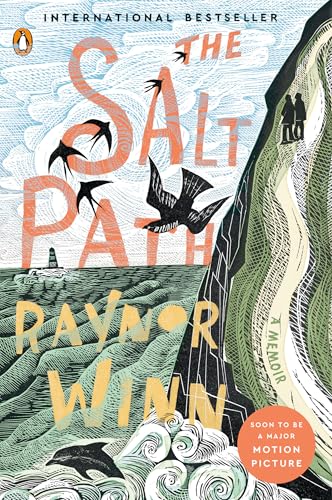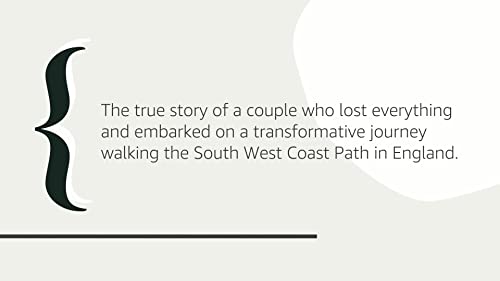Alright, folks, gather round—because today I’ve got a review of Raynor Winn’s book that’ll knock the sand out of your boots. Now, before you start thinking this is just another stroll along the English seaside, let me assure you, there’s more to this story than sea spray and soggy socks. This review will touch every part of Raynor and Moth’s wild journey: hope, gritty hardship, love, and more sheep than I usually see outside my cousin Barry’s farm. So, pack your raincoat (and your tissues, trust me), and let’s get started.
In a nutsheel
Raynor Winn’s book is a real-life adventure, and trust me, you won’t find any dragons—just blisters, rain, and some very curious sheep. This memoir is about Raynor and her husband Moth walking the South West Coast Path after they lose their home and get some awful news. It’s part travel book, part survival tale, and a bit of a love letter to the wild English coast.
The writing soaks you in the beauty of nature, the pain of losing everything, and the stubborn hope that keeps you putting one foot in front of the other. While it’s technically a memoir, it reads like a mix of travel writing and an underdog story. Themes of resilience, love, and starting over run through every muddy step.
If you like books that make you laugh, cry, and want to go on a walk (okay, maybe just to the corner shop), this is a great pick. Just remember to pack your snacks and tissues.
Resilience and Hope: Raynor Winn’s Unbeatable Spirit
Raynor Winn knows how to turn life’s rotten lemons into lemonade. Picture this: You lose your home, your husband gets a tough health diagnosis, and suddenly the only thing you own is a rucksack. Most folks would curl up and binge-eat biscuits (I know I would). Raynor? She and her husband, Moth, hit the South West Coast Path. That’s over 600 miles with nothing but blisters, tired legs, and a tent that looked like it had already lost a fight with a strong breeze.
Let me tell you, reading Raynor’s journey in The Salt Path had me reaching for tissues, but also itching to put my shoes on—until I remembered I hate blisters. Through each page, her honesty grabs you. She never pretends that sleeping rough is romantic, or that every day is inspirational. Some days, it’s mud, rain, and questionable trail snacks. But that’s where her true grit shines. It’s about small joys: a sunrise after a rainy night, a kind stranger with a flask of tea, or that ache in your legs that says, “Hey, you’re still moving.”
I’ve moaned after one rainy walk to the pub, but Raynor makes you believe that hope grows even in the muddiest places. Her story isn’t just about surviving, but about laughing in the face of trouble, and finding love in simple, wild moments. If you’ve ever wanted proof that you can start again, she delivers it, one step at a time.
Next, let’s pull on our imaginary wellies and see how Raynor paints the wild, windy English coast like nobody else—bring your own snacks!
Stunning Scenes: The English Coast in Raynor Winn’s Words
I’m going to say it straight: if there was an Olympic sport for describing the English coastline, Raynor Winn would be wearing gold, silver, and probably a bronze just for good measure. Seriously, her writing about the South West Coast Path makes me want to lace up my boots, put on several waterproof layers, and walk straight into a horizontal Cornish rainstorm with a big grin. She brings the beaches, cliffs, muddy estuaries, and wild sea air right into your lounge, which is handy when you live nowhere near the coast (like me, stuck in a landlocked town with more roundabouts than seagulls).
Raynor doesn’t just give you the postcard version. She writes about every stone underfoot, every bluster of wind that could blow your hat off, and every shade of grey the sky can manage in a single afternoon. I can nearly taste the salty spray and feel my socks getting soggy. She’s not afraid to show the coast on a bad day: the sort of rain that makes you question your life choices, the headlands looming like stubborn old grandpas, and endless fields of gorse that scratch at your legs. But she also manages to find beauty in the fog and magic in the mud.
What’s great is how she pulls you into the landscape, even if you’ve never been there, or even if your idea of a wild hike is fighting the crowds at your local Aldi. I actually found myself looking up Google images just to see if the coast really is as wild and lovely as she says (spoiler: it is!).
Next up, we’ll get our feet a bit more muddy as we chat about homelessness and poverty—spoiler alert, it’s a lot less scenic but a lot more real.
Facing Hard Times: Homelessness and Poverty in Raynor Winn’s Story
Homelessness is one of those things you hear about on the news, but never think will happen to you. Raynor Winn and her husband Moth thought the same. Then, thanks to a business deal gone bad, they were tossed out of their farmhouse faster than I lose my keys (which is, honestly, very fast). Just like that, their whole world got flipped like a pancake at a Sunday brunch.
Winn doesn’t sugarcoat the gritty reality. Imagine every day wondering where to sleep, or if your last twenty quid will stretch far enough for a hot meal (spoiler: it won’t). She details how the shame and isolation can be worse than the cold. It hit me hard, thinking about the pride I sometimes feel just for making my bed. These two had to park their pride at the side of the road with their old mattress.
The book makes it clear: poverty doesn’t care if you’re smart, hardworking, or have a killer recipe for apple crumble. Winn shows how quickly things can unravel, especially when the world keeps moving and you’re stuck walking with blistered feet.
Still, she finds humor in bleak moments—like eating noodles with a broken fork, or chatting with other wanderers who are just as lost. That’s the kind of honesty you don’t get from a statistics report.
Next up, get ready to eavesdrop on how all this madness brought Raynor and Moth closer together… or maybe not! Spoiler alert: It’s juicer than a soap opera at Sunday dinner.
How Relationships Change You: Lessons from Raynor Winn
Let’s be honest, walking a super long, muddy path with your partner is either a solid trust exercise or grounds for a reality TV show. In Raynor Winn’s book, she and her husband Moth prove that being broke, cold, and wet is not the death of love—it’s where the real stuff comes out. I mean, if my partner and I had to spend every night in a tiny tent, one of us would run off with a passing sheepdog by day four. But Raynor and Moth? They figure things out.
The book touches a nerve for anyone who’s tried not to strangle their soulmate after setting up a tent in the rain. But unlike your average relationship drama, Raynor keeps it gentle. She describes the aches and sometimes sharp words, but she never paints her partner as the villain. There’s a brutal kind of honesty to the way she talks about fear, illness, and stubborn hope. Lots of real folks can relate—even if they’ve never wild-camped a day in their lives.
What makes it stick is Raynor’s humour. It’s weirdly comforting to read about someone bickering over instant noodles and then, two pages later, sharing a sunset and deep feelings. The emotional growth is not just for her but for the reader, too. I found myself rethinking my own grumpy moods after a bad day.
Recommendation? Oh, absolutely—read this book if you need a boost in hope and maybe want to hug your partner (or at least not throw a sock at them).
Conclusion
Well, there you have it—my review of Raynor Winn’s moving memoir, all wrapped up and ready to go. If you want a book that takes you on a wild stroll along the English coast, dishes out hope with every page, and reminds you that love can survive a tent full of wet socks, this is your read. Sure, it sometimes gets a bit heavy with the hardship, and you might find yourself craving a hot shower by chapter ten, but Winn’s honest writing and dry humor shine through. I had a good time with this one, even when I ruined our family camping trip by quoting too much of it (sorry, mum). So, if you fancy a story about fighting back when life knocks you flat, grab Raynor’s book and hit the trail—at least in your imagination. That’s it from me. Review over, shoes off, kettle on!



